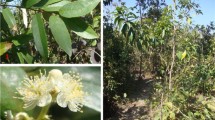Abstract
Bryophytes, the shade loving plants, have tremendous medicinal properties. The aqueous and alcoholic extracts of Atrichum undulatum (Hedw.) P. Beauv. were analysed for antimicrobial properties against the fungi Aspergillus fumigatus and Fusarium oxysporum and the bacteria Escherichia coli, Bacillus mycoides, Proteus mirabilis, Staphylococcus aureus and Salmonella typhi. The study is an attempt to investigate the medicinal properties of Atrichum undulatum (Hedw.) P. Beauv. using disc-diffusion method. No inhibition was observed against A. fumigatus and P. mirabilis. For bacteria S. typhi and E. coli (20 and 15 mm), aqueous and alcoholic extracts of Atrichum showed significant inhibition. However, alcoholic extract was found remarkably effective against bacteria rather than aqueous extract.

Similar content being viewed by others
References
Alam A, Sharma V, Rawat K, Verma P (2015) Bryophytes the ignored medicinal plants. SMU Med J 2:299–316
Asakawa Y (2008) Liverworts-potential source of medicinal compounds. Curr Pharm Des 14(29):3067–3088. https://doi.org/10.2174/138161208786404272
Banerjee RD, Sen SP (1979) Antibiotic activity of bryophytes. Bryologist 82:141–153
Basile A, Giordano S, Sorbo S, Vuotto ML, Lelpo MTL, Cobianchi RC (1998) Antibiotic effects of lunularia cruciata (Bryophyta) extract. Pharm Biol 36(1):25–28:https://doi.org/10.1076/phbi.36.1.25.4612
Basri DF, Fan SH (2005) The potential of aqueous and acetone extracts of galls of Quercus infectoria as antimicrobial agents. Indian J Pharmacol 37:26–29
Chandra H, Bishnoi P, Yadav A, Patni B, Mishra AP, Nautiyal AR (2017) Antimicrobial resistance and the alternative resources with special emphasis on plant-based antimicrobials—a review. Plants 6:16
Chopra RS (1975) Taxonomy of Indian mosses. An introduction. Botanical Monograph no 10. Publication and Information Directorate (C.S.I.R), New Delhi
Decker EL, Gorr G, Reski R (2003) Moss—an innovative tool for protein production. BIOforum Europe 2:96–97
Dey A, De JN (2011) Antifungal bryophytes: a possible role against human pathogens and in plant protection. Res J Bot 6(4):129–140
Frahm JP (2001) Biologie der moose. Spektrum Verlag, Berlin
Harris ESJ (2008) Ethnobryology: traditional uses and folk classification of bryophytes. Bryologist 111:169–217
Kang TH, Hwang EI, Yun BS, Park KD, Kwon BM, Shin CS, Kim SU (2007) Inhibition of chitin synthases and antifungal activities by 2′-benzoyloxycinnamaldehyde from Pleuropterus ciliinervis and its derivatives. Biol Pharm Bull 30(3):598–602
Krzaczkowski L, Wright M, Gairin JE (2008) Bryophytes, a potent source of drugs for tomorrow’s medicine? Med Sci 24(11):947–953
Lal J (2005) Checklist of Indian mosses. Bishen Singh Mahendra Pal Singh, Dehradun, pp 1–164
Nakagawara S, Katoh K, Kusumi T, And Komura J, Nomoto K et al (1992) Two azulenes produced by the liverwort, Calypogeia azurea, during in vitro culture. Phytochemistry 31:1667–1670
Nikolajeva V, Liepina L, Petrina Z, Krumina G, Grube M, Muiznieks I (2012) Antibacterial activity of extracts from some bryophytes. Adv Microbiol 2:345–353
Singh M, Govindrajan R, Nath V, Rawat AKS, Mehrotra S (2006) Antimicrobial, wound healing and antioxidant activity of Plagiochasma appendiculatum Lehm et Lind. J Etnopharmacol 107(1):67–72
Snedecor GW, Cochran WG (1987) Statistical methods. Iowa State University, Oxford
Üçüncü O, Cansu TB, Özdemir T, Alpay-Karaoğlu Ş, Yayli N (2010) Chemical composition and antimicrobial activity of the essential oils of mosses (Tortula muralis Hedw., Homalothecium lutescens(Hedw.) H. Rob., Hypnum cupressiforme Hedw., and Pohlia nutans (Hedw.) Lindb.) from Turkey. Turk J Chem 34:825–834
Vats S, Alam A (2013) Antibacterial activity of Atrichum undulatum (Hedw.) P. Beauv. Against some pathogenic bacteria. J Biol Sci 13:427–431
Vats S, Tiwari R, Alam A, Behera KK, Pareek R (2012) Evaluation of phytochemicals, antioxidant and antimicrobial activity of in vitro culture of Vigna unguiculata (L.) walp. Researcher 4:70–74
Author information
Authors and Affiliations
Corresponding author
Rights and permissions
About this article
Cite this article
Saxena, K., Yadav, U. In vitro assessment of antimicrobial activity of aqueous and alcoholic extracts of moss Atrichum undulatum (Hedw.) P. Beauv.. Physiol Mol Biol Plants 24, 1203–1208 (2018). https://doi.org/10.1007/s12298-018-0589-1
Received:
Revised:
Accepted:
Published:
Issue Date:
DOI: https://doi.org/10.1007/s12298-018-0589-1




